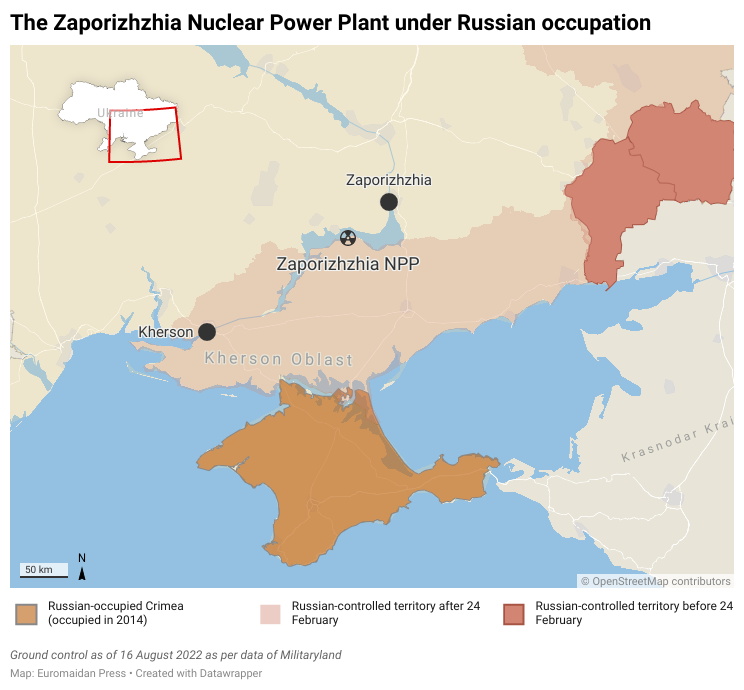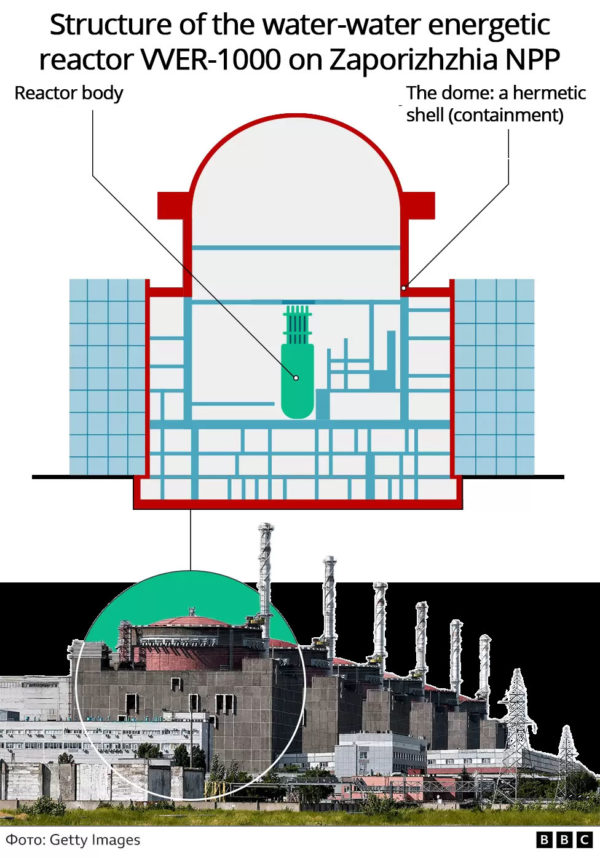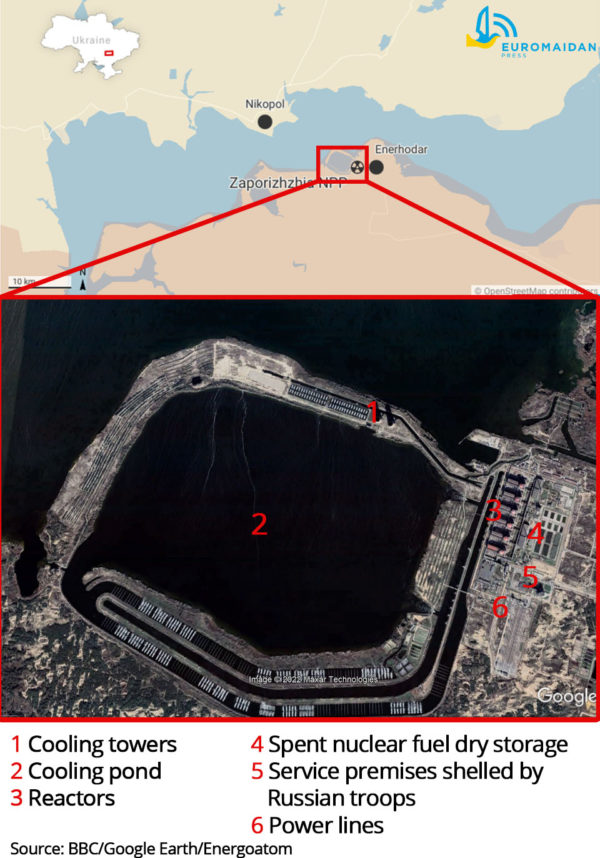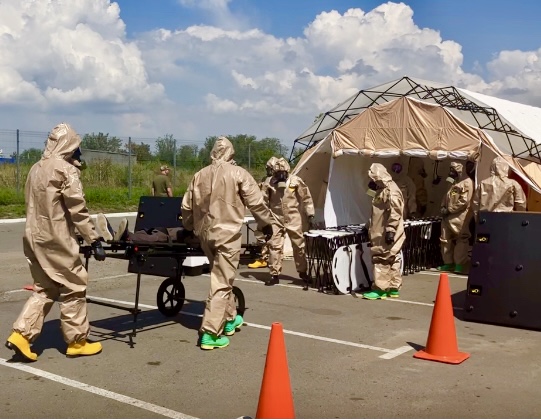On the wee hours of 4 March 2022, a week after the beginning of the full-scale invasion, the Russian Federation troops captured the Zaporizhzhia nuclear power plant (NPP), the largest nuclear plant in Europe, which generates 40 billion kW of electricity, 1/5 of the total annual electricity production in Ukraine, with a total capacity of 6,000 megawatts.
https://twitter.com/aletweetsnews/status/1499544718169968640
The Russian military shelled the station from the air and tanks and the fire engulfed the training facility building while the world watched. The rescuers were not allowed on site.

The Russian artillery shelling set an administrative building on fire and damaged one of the containment vessels but the station remained in operation. The power plant has been occupied by Russian troops since 6 March, with Russian equipment and weapons being stored on its territory, but is operated by the Ukrainian crew. Rosatom personnel is also present on site at Zaporizhzhia nuclear power plant. Ukrainian authorities announced that they cannot guarantee safety and called for the international atomic energy watchdog, International Atomic Energy Agency (IAEA), to help.
After the plant was captured, as the Ukrainian authorities and western states say, the Russian Army conducts shelling from the territory of the station. US State Secretary Anthony Blinken stated that Russia uses the station as a military base to shell Ukrainians, as they will not fire back for fear of hitting the reactor.
Petro Kotin, head of Ukraine's Energoatom agency, says that up to 50 units of Russian heavy equipment are at the station, including Urals with explosives, and up to 500 Russian soldiers.
On 5 and 7 August 2022, repeated shelling of the NPP was reported. Shells hit high-voltage power lines and one of the power units was turned off. Ukraine and Russia exchanged accusations and Russia requested a special session of the UN Security Council for 11 August. At the meeting of the Security Council, the Russian Special Representative at the UN said that in the event of the withdrawal of Russian troops from the Zaporizhzhia nuclear power plant “monstrous provocations” could happen.
First Deputy Minister of Internal Affairs Evhen Enin: the situation at the #Russian occupied #Zaporizhzhia nuclear power plant is a "huge threat."
"We saw many cruise missiles flying over the #nuclear power plant." #NuclearTerrorism #RussianWarCrimes
🎥 @ZarinaZabrisky pic.twitter.com/TxJurPIzVE
— Euromaidan Press (@EuromaidanPress) August 17, 2022
The IAEA and the US National Security Council later clarified that no radiation leakage was recorded after the shelling, yet the IAEA noted that there is a risk of a nuclear catastrophe. Ukraine, the UN, and the US insist on creating a demilitarized zone around the NPP, while Russia rejects any such possibility.
On 1 September, the IAEA team finally reached the nuclear power plant after delays, as the Russians did not give it a special pass. 14 experts stayed at the captured station for 2.5 hours, after which only five representatives of the mission remained at the nuclear power plant.
Director General of IAEA Rafael Grossi said that the IAEA team will maintain its presence at the Zaporizhzhia NPP.
Ukraine's President Volodymyr Zelenskyy said that despite the agreement with Mr. Grossi, the mission arrived at the Zaporizhzhia NPP without independent journalists. An agreement on the demilitarization of the plant has not yet been reached.
In the meantime, Ukrainian officials are preparing for the worst, and nuclear safety drills are being held in Zaporizhzhia.
What will happen in case of an accident at a #nuclear plant?@EuromaidanPress reports from the Ukrainian emergency and rescue team drills in #Zaporizhzhia, with the Minister of Energy and Minister of Internal Affairs of #Ukraine in attendance.
🎥 @ZarinaZabrisky pic.twitter.com/9XxatYsUeA— Euromaidan Press (@EuromaidanPress) August 17, 2022
What is the worst that could happen at the station: scenarios
1. Leakage of radiation from a missile strike
A Chornobyl-type accident, where an explosion at the nuclear reactor and subsequent fire led to large-scale radioactive contamination, comes to mind when Ukrainian officials warn of a possible nuclear catastrophe. However, the type of nuclear reactor used at the Zaporizhzhia NPP precludes that possibility. In the Chornobyl NPP, graphite was the element that slowed down the nuclear reaction. After a malfunction, the graphite caught fire and greatly contributed to the spread of radioactive materials.
However, in Zaporizhzhia NPP's reactor type VVER-1000, neutrons are slowed down by water; as well, it constantly cools the active zone of the reactor. The heated water is converted to steam and sent to turbines that produce electricity.

The reactor itself is situated inside a hermetic shell, a big concrete structure with walls over one meter thick. In the case of an accident, it is called to prevent radioactive substances from spreading. This is another way that the Zaporizhzhia NPP is different from Chornobyl, which lacked such a containment structure, as a result of which radioactive substances spread into the air.
The containment was designed to withstand many physical influences, like a small airplane falling or an explosion next to the energy block. However, a targeted missile or rocket strike could damage it.
Would that mean that the reactor would be damaged as well? Nuclear physicist Oleksandr Kupnyi, who worked at both the Chornobyl and Zaporizhzhia NPP, believes it would take two targeted strikes one after the other into the same location to damage the reactor, after which radioactive substances could leak through the hole. And even then, to get any considerable spread of radiation, all six energy blocks would have to be damaged.
In this case, the area of the nuclear power plant would be most contaminated by radioactive materials; nearby settlements, depending on the wind conditions, would also be impacted.
But not only reactors contain radioactive substances. After radioactive fuel is spent, it spends five years cooling off in a spent fuel pool, which in the Zaporizhzhia NPP is located inside the containment. This fuel pool needs water, without the cooling effect of which the spent fuel could heat up and catch fire (if it is still relatively fresh from the reactor).
It is theoretically possible that a missile strike may damage the fuel pool, but more likely is the scenario that a missile strike damages the place where the spent fuel is stored after five years in the pool -- the dry storage facility.

These are 174 ventilated concrete containers located in a designated fenced area within the nuclear power plant. They don't have the hermetic protection that the reactor has, so they are more vulnerable to damage from warfare, despite still being rather sturdy constructions designed to withstand fire or a grenade launcher, as Pavlo Podvykh, a researcher at the United Nations Institute for Disarmament Research, told BBC
.
If a missile strikes the spent fuel dry storage containers, there will be a release of radioactive materials, since long-lived nuclides are still present in spent fuel, but it will be local, within a distance of 10-30 meters, Mr. Podvykh told. The contamination will be local since the spent fuel has already cooled down and is unlikely to cause a fire that could potentially sweep up the radionuclides in the atmosphere.
However, more dangerous is the fact that the Russians damaged the monitoring system for monitoring processes in the spent fuel sector, Oleksandr Kupnyi believes. This could lead to uncontrolled heat buildup inside the containers, and potentially -- to a Kyshtym-type nuclear disaster, rated as the third-worst nuclear disaster, after the accidents at the Chornobyl and Fukushima nuclear power plants. Loss of control over a tank with liquid radioactive waste led to it heating up and an explosion that tore open the concrete lid. As a result, 800 to 20,000 km2 of surrounding territory was radioactively contaminated.
2. Loss of electricity could lead to a Fukushima-type accident
Losing electricity at Zaporizhzhia nuclear power plant can lead to failure of the cooling systems and damage to the active zone of the reactor plant and result in the release of radioactive substances into the environment.
Even though after the accidents at Chornobyl (1986) and the Fukushima (2011) nuclear power plant accidents, the industry safety guidelines have improved, losing power at Zaporizhzhia can lead to a Fukushima-type accident, according to the State Inspection of Nuclear Regulation of Ukraine.
Zaporizhzhia nuclear power plant has six power units. All of them must have a constant power supply — either internally or externally — to ensure the cooling of both nuclear fuel in the working part of the reactor and of spent fuel in holding pools.
The Russian troops damaged three out of four power lines connecting the nuclear power plant to the energy system of Ukraine. Two were damaged in the first week of March after the Russian troops captured the Zaporizhzhia nuclear power plant. Another one was damaged as a result of Russian shelling on March 16.
If the fourth power line stops working, a diesel generator will be used to supply electricity to the pumps circulating water through the cooling system. The NPP has three diesel generators; with the most sparing use of fuel, they can work four days
at most. After that, the cooling system will stop working and this will lead to an uncontrolled heat buildup in the reactor active zone.
The scale of the accident could be serious, up to a meltdown of the active zone, like in Fukushima, and a fire that could release and spread radiation from the containment structure into the environment.
If the incident with damage to the active zone or the cooling pool will be serious, it is possible that radioactive contamination will affect territory with a radius of 100-200 km or even more, depending on the wind, Pavlo Podvyh told BBC.
"I wouldn't paint a very gloomy picture, but, on the other hand, one must understand that there can be quite serious consequences in the sense of radioactive contamination," the expert said.
"I do not think that this background will immediately lead to the death of people, no one will die immediately. But it is clear that there will be economic losses, there will be an exclusion zone. The consequences may not appear immediately, but in the long term they can be very serious," he warned.
This scenario came chillingly close to implementation on 25 August, when for the first time in history it was completely cut off from the power supply. This happened because the last remaining high-voltage power line shut off due to the effect of fires that erupted from the consequences of shelling.
That time, the backup diesel system kicked in and powered the cooling mechanism until the station was reconnected to the Ukrainian power system on 26 August.
3. Mistake of tired personnel
The scenarios of radiation leakage as a result of missiles hitting the nuclear power plant or a malfunction of the cooling system are currently drawing the most attention and speculation.
But for radiobiologist Olena Pareniuk, who works at the Institute for problems of safety of Ukrainian nuclear power plants, a third scenario poses the most risks: that the personnel of the nuclear power plant, exhausted from the pressure of working at an object under Russian occupation and the constant intimidation of the occupiers, may lose control over the complex processes that go on inside a nuclear power plant.
“[The explosion at Chornobyl NPP in 1986] took place because of a mistake of the operators and because the operators did not have the freedom to do what they should do. Speaking otherwise, they knew they needed to turn off the reactor, but Moscow told them to switch it on and heat it up. This could happen at Zaporizhzhia NPP. It’s technically more difficult, but the operators are all people and they live under conditions of terrible psychological pressure. It could be not a mistake, but sabotage, when a person with a gun simply does not allow operators to do their job,” Pareniuk notes.
She does, however, add that after the 1986 Chornobyl incident, safety measures have been greatly improved at nuclear power plants and that the staff has undergone rigorous training to prevent nuclear catastrophes. The expert also stresses that an accident on the scale of Chornobyl is impossible due to the different reactor models.
What is the psychological pressure that the staff face? An employee of the plant told journalist Inna Zolotukhina about the situation under conditions of anonymity. While granted, the Russians do not interfere in the work of the personnel, they do eavesdrop on their conversations and if an employee is suspected of anti-Russian sentiments, he/she will be imprisoned for 15 days in the “basement” and be subjected to interrogations, beatings, torture by electricity, and sleep deprivation.
Some personnel was driven to the “forest,” the employee told, where they were subjected to mock executions, tied to trees, and forced to dig their own grave.
“It’s incredible that this is happening in the 21st century,” the employee said.
He notes that the Russians had detained, intimidated, and tortured approximately 300 employees.
4. Russia could disconnect the station from the Ukrainian grid
The fourth scenario of what Russia could do with the Zaporizhzhia NPP does not concern radioactive accidents. However, it is extremely dangerous for Ukraine’s economy: Russia could reroute the power plant to its own grid.
And disconnecting the nuclear power plant from Ukraine's power grid is exactly what Russia’s goal is for the plant, according to Ukrainian intelligence. In an interview with RBC,
Ukraine’s Main Intelligence Directorate representative Vadym Skibitskyi explained that Russia’s rationale behind the move is to supply occupied Crimea with electricity.
Prior to being occupied by Russia in 2014, Crimea had a deficit of electricity. In 2015 Ukraine stopped providing power to the Russian-occupied peninsula, which led to regular rolling blackouts.
The issue was fixed after launching two gas power plants in Simferopol and Sevastopol in 2018-2019, with the help of the German techno-giant Siemens who supplied the gas turbines required for these plants in violation of EU sanctions.
But the power plants required gas. And to fuel them, Russia had been stealing Ukrainian gas produced at Ukrainian gas rigs dubbed “Boiko Towers” in the Black Sea. Until June 20, when the Ukrainian Army destroyed them with a missile strike. This puts Crimea at risk of blackouts once again.
Ukraine’s loss of the plant would mean that the entire south of Ukraine would be deprived of a major power source, as the station produces 20% of Ukraine’s electricity.
It would also mean that Ukraine will lose the opportunity to export electricity to the European Union, and will lose more than EUR 3.5 bn per year.
Only an increase in production at coal-fired plants could save the situation for Ukraine’s south in its hardest-yet winter, should the NPP be disconnected. However, given the shortage of coal, Ukraine may also need to purchase electricity from the EU, which would put additional pressure on its war-torn economy.
On 9 August, Russia began to roll out a plan to reroute the Zaporizhzhia NPP to the Russian grid.
President of Enerhoatom Petro Kotin informed that Rosatom personnel, who are located at the plant, presented a special program to connect the Zaporizhzhia NPP to Crimea. The prerequisite of the program is to damage the power lines connecting the Zaporizhzhia NPP with the energy system of Ukraine.
Three out of four lines of the Zaporizhzhia NPP are already damaged. On August 25, the only remaining working line had been disconnected from Zaporizhzhia NPP for the first time in history. Now it is operating again.
Additional risk factors are malfunctioning of the fire safety, ventilation, and monitoring systems.
Earlier, an artillery strike damaged the nitrogen-oxygen station, the combined auxiliary building, and the domestic sewage pumping station of the heat and underground communications workshop, and the other destroyed the fire department responsible for the safety of the nuclear power plant. The 750 kV open switchgear (VRP-750) was also damaged. The risks of hydrogen leakage, sputtering of radioactive substances, and fire are high. In addition, three radiation monitoring sensors were damaged. Earlier, the International Atomic Energy Agency (IAEA) stopped receiving data from the safety monitoring system.

